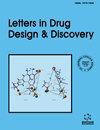"类铅药物 "中的环
IF 1.6
4区 医学
Q4 CHEMISTRY, MEDICINAL
引用次数: 0
摘要
背景:分子量(MW)为 300 Da 的类铅药物在制药领域占有重要地位。这些小分子大多具有环系统,这对其理化性质和生物活性非常重要。以往的研究已经对历史药物或临床试验候选药物中的环系统进行了评估。目的:这项工作的目的是分析环系统,重点是分子量为 300 Da 的这类药物,以获得具体的见解。研究方法从以前的出版物中获得类先导药物(n = 219),之后获得 FDA 的新药批准,并使用 DataWarrior 软件进行分析。结果大多数类先导药物(> 92%)都有一个或两个环,其中以苯环和杂环系统为主。吡啶、咪唑、哌啶、4,5-二氢-1-咪唑和吲哚是最常见的杂环。值得注意的是,4,5-二氢-1H-咪唑环在类铅药物中出现的频率较高,这在其他药物中没有发现。多年来,类铅药物和历史药物中引入新环的情况类似;例如,抗菌药陶乐定(Taurolidine)中含有 1,2,4-噻二嗪环 1,1-二氧化物,它参与了药物的代谢活化。结论总的来说,类铅药物中的环系统似乎与历史药物的模式相似。此外,很少有新的环系统出现,这表明这是药物发现中有待探索的一个新兴领域。本文章由计算机程序翻译,如有差异,请以英文原文为准。
Rings in “Lead-like Drugs”
Background: Lead-like drugs, which present molecular weight (MW) < 300 Da, occupy an important space in the pharmaceutical area. Most of these small molecules have ring systems, which are important for their physicochemical properties and biological activity. Previous studies have evaluated ring systems in historic drugs or drug candidates in clinical trials. Objective: The purpose of this work was to analyze ring systems, focusing on this group of drugs with MW < 300 Da, to obtain specific insights. Methods: The lead-like drugs (n = 219) were obtained from previous publications and the new FDA drug approvals were obtained after that and analyzed using the DataWarrior software. Results: Most of the lead-like drugs (> 92%) present one or two rings, with the benzene ring and heterocycle ring systems being predominant. Pyridine, imidazole, piperidine, 4,5-dihydro-1Himidazole, and indole are the most frequent heterocycles in this set. The higher frequency of the 4,5- dihydro-1H-imidazole ring in the lead-like drugs is worth noting, as it is not observed in other drugs. The introduction of new rings has been similar in the lead-like drugs and the historic drugs, over the years; an example would be the 1,2,4-thiadiazinane 1,1-dioxide, which is present in the antimicrobial Taurolidine, a lead-like drug, and engages in the metabolic activation of the drug. Conclusion: In general, the ring systems in the lead-like drugs appear to follow similar patterns to the historic drugs. Additionally, few new ring systems are being introduced, which suggests that this is an emergent field to be explored in drug discovery.
求助全文
通过发布文献求助,成功后即可免费获取论文全文。
去求助
来源期刊
CiteScore
1.80
自引率
10.00%
发文量
245
审稿时长
3 months
期刊介绍:
Aims & Scope
Letters in Drug Design & Discovery publishes letters, mini-reviews, highlights and guest edited thematic issues in all areas of rational drug design and discovery including medicinal chemistry, in-silico drug design, combinatorial chemistry, high-throughput screening, drug targets, and structure-activity relationships. The emphasis is on publishing quality papers very rapidly by taking full advantage of latest Internet technology for both submission and review of manuscripts. The online journal is an essential reading to all pharmaceutical scientists involved in research in drug design and discovery.

 求助内容:
求助内容: 应助结果提醒方式:
应助结果提醒方式:


